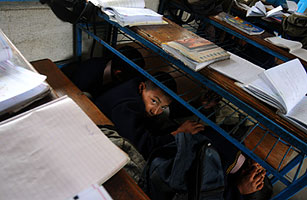
In rows of benches with barely an inch between each other’s crisp blue-and-red uniforms, the kids dutifully listen to their teacher’s lesson. Once dismissed, they dash out, forming a bottleneck in the narrow passage that constitutes the hallway in this school in Kathmandu. Dozens of children fill each of the cramped rooms in the bare, crudely assembled three-story building. Most of the Nepalese capital’s thousands of schools are housed in rudimentary, ill-maintained buildings, but this one happens to be uniquely sturdy. A few strategic vertical and horizontal strands of brick, fortified by steel-reinforced concrete, have been laid over the building’s original adobe walls. It is among a small fraction of the South Asian nation’s schools — or any private or public buildings, for that matter — designed to withstand a major earthquake.
This is not an abstract consideration. Nepal sits at the meeting point of the Eurasian and Indian tectonic plates, and the same seismic power that long ago produced the Himalayan mountain range continues to make the country an earthquake hotspot. Geologists have identified the region as due soon for a major earthquake, putting millions of people in danger and the nation’s fragile economy at further risk. “The Kathmandu valley, unfortunately, has everything that Port-au-Prince has and more,” says Robert Piper, the head of UN humanitarian operations in Nepal.
Working against the clock and with limited resources, a local NGO has been retrofitting a few dozen schools and hospitals in Kathmandu, and providing emergency response training to a few hundred more. The strands of brick and steel installed on the walls of the buildings act “like a rubber band,” holding the structure together even if it were to sway, says Surya Prasad Acharya, an engineer with the National Society for Earthquake Technology . Though not pretty, NSET’s renovations are simple, quick and cost-effective, which is crucial. Nepal is among the world’s poorest countries and its government has been largely dysfunctional in recent years because of infighting and civil strife.
The departure on Jan. 15 of a U.N. peacekeeping mission, which for four years oversaw the country’s post-war transition following an insurgency by Maoist groups, isn’t likely to hasten the new constitution necessary for the government to regain the kind of powers needed to install, let alone fund, a cohesive national response plan. Such problems, however, will do nothing to delay the major earthquake that geologists expect will soon strike.
“Here, the disaster-risk-reduction per dollar will have to be much lower than [it is in ]California,” says NSET’s director, Amod Dixit, who sees California as a model of the earthquake-preparedness resources that Nepal sorely lacks. The Golden State is spending more than $6 billion to overhaul the San Francisco-Oakland Bay Bridge for earthquake safety; Nepal has a population roughly similar to California’s and yet it’s not clear its government’s annual spending on earthquake preparedness is even in the millions. There are tens of thousands of schools and hospitals in Nepal and NSET estimates that about 1% have received substantial safeguards.
Working with a limited pool of funds from international donors, NSET has assumed a pragmatic approach. Kathmandu’s buildings are unsafe, in part, because 90% are designed by traditional masons instead of professional engineers. NSET accepts this as a reality of local poverty and so it trains masons, despite their humble skills, in the science of earthquake-resistant renovation. The task ahead of them is daunting: two-thirds of the capital’s structures aren’t fit to withstand a quake of 8-plus on the Richter scale, say NSET and the government.
Though a day looking around Kathmandu would have an observer believing otherwise, Nepal has had a building code since 1993. “There are regulations but they are not followed,” says Suresh Prakash Acharya, a high-ranking official at the Ministry of Physical Planning and Works in charge of urban development. He acknowledges “very little has been done” to protect the city, whose buildings have fast grown in number and height but not quality in a improvised attempt to house a population that has doubled in just a decade. But he says the country’s political instability undermines his ability to reign-in municipal authorities, who control the distribution of building permits and rarely conduct due diligence.
It’s not just its buildings that make Kathmandu so vulnerable to the effects of a major quake. Like its seismically unstable cousin, Mexico City, Kathmandu sprawls over the soft sediment of an ancient lakebed and is surrounded by mountains. This combination can magnify seismic power by ten times, says Brian Tucker, president of GeoHazards International. A 2001 study by the California-based NGO ranked Kathmandu the most vulnerable to damage by a major earthquake of twenty high-risk cities it assessed